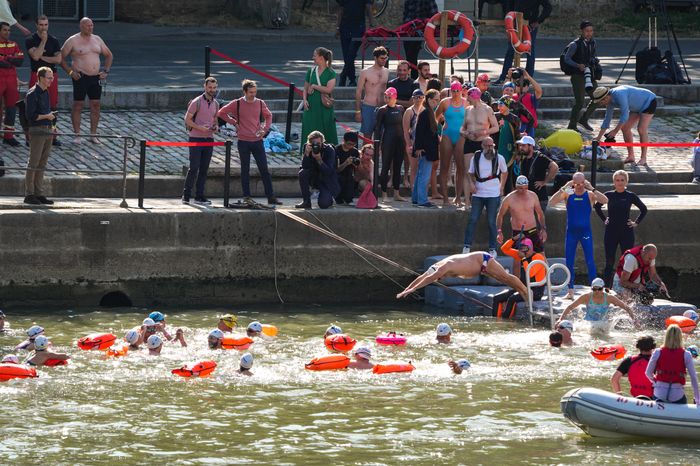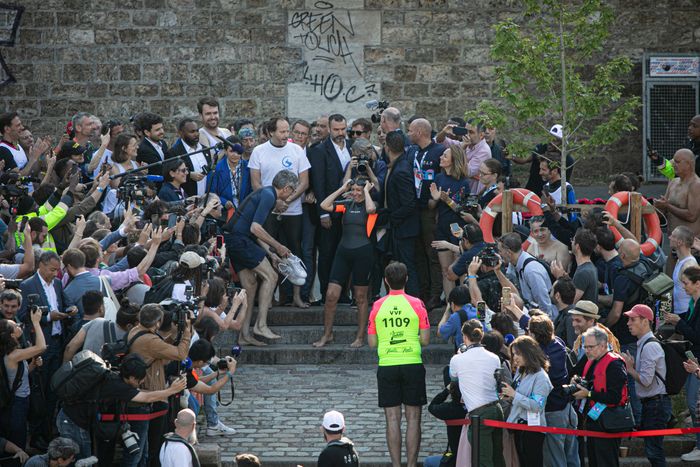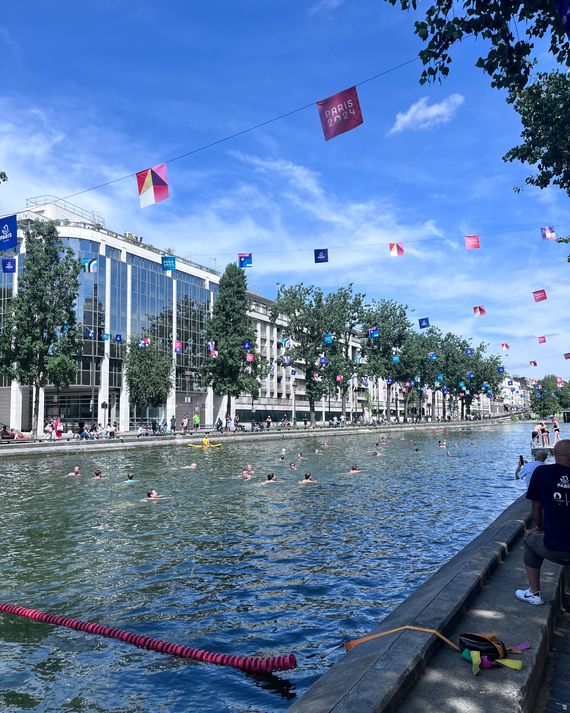What It Was Like to Swim in the Seine During the Olympics

Photo: Xu Chang/Xinhua/Getty
“Chaud?” I asked, in my stilted French. The swimmer, emerging out of Canal Saint-Martin in Paris on a recent Sunday, laughed and replied in English: “Yes, warm!” He was right, sort of. When my partner and I jumped into the water from a floating dock, it was chilly at first, but then the water began to feel warmer, like a bathtub filling up with hot water.
We had decided to brave Paris Plages, a citywide effort renewed during the 2024 Summer Olympics to set up temporary public beaches along the Seine. This canal spot was one of six locations where swimmers could directly enter the water (and not a floating pool) for the first time since 1923. We were a bit nervous, of course; we were submitting our bodies to the question of whether one of the largest urban water cleanups in recent history had worked. Had France’s operation to detox the river Seine and its canals succeeded? How clean was the water, really?
A tolerable test result for E. coli, enterococci and other fecal bacteria by public health officials that morning gave us the green light to swim. The canal felt like a lake, tepid and murky. Sticks and algae floated past and stuck to our ankles, and we couldn’t see our feet. The ground felt like it was covered with a mossy slime. Some swimmers gleefully did laps like it was any other pool, as lifeguards looked on, but others were squeamish: we watched a group of teens spot a floating clump of weeds after jumping in. They got their picture and they got out. We stayed for another half hour. Thankfully there were public showers (a mandatory stop for anyone getting in the water) across the street.
Local residents swim in the Seine River on July 17, 2024.
Photo: Xu Xhang/Xinhua/Getty
Prior to this year, swimming has been banned in the river for a century. Before that, it was common, if not en vogue, to take a dip along its shores, or at one of the many floating pools that lined it. But over time, the Seine grew dirty from industrial pollution, like so many other city waterways. Soon, nobody would think of swimming there—much less remember that you once could. This year, somewhat improbably, two major Olympics events—marathon swimming and the triathlons—were scheduled to take place there.
The goal of the cleanup isn’t just making the water work for athletic competition; it’s to get it clean enough to support five permanent swimming spots within Paris and up to 23 more across the region by next year. On this front, there has been steady progress. Fish species have grown in number. The level of bacteria found in 2022 tests indicated it was suitable for swimming 91 percent of the time, according to Bloomberg. While the city had launched Paris Plages in 2002 to entice city dwellers who would normally head to Normandy or Nice for lad mer to instead spend time at their own riverfront, officials didn’t fully permit swimming until this year.
But the problem that persistently plagues the Paris waterway is one that is also familiar to New Yorkers: combined sewer overflow. Even with the $1.5 billion France spent building a new storm drain with the capacity of 30 Olympic-sized pools to divert wastewater and runoff, so much of the city and region—including thousands of residential pipes upstream—are still set up to flush right into the river. This means that even a brief rainfall sends untreated sewage into the water. An earlier attempt in 2017 to allow swimmers on select Sundays to enter the Canal Saint-Martin, when the locks could be closed and the water tested, was cut short by a bacteria outbreak. These stop-and-starts have become common. A few days before the opening ceremony, Paris’s mayor Anne Hidalgo took a literal victory lap in the Seine for news cameras. But a two-day rainfall that weekend flooded sewers and sank testing, delaying the men’s triathlon for a day. Then Belgium announced that it would be dropping out of the mixed triathlon the coming Monday. One of its athletes, Claire Michel, had fallen ill (although her sickness wasn’t linked to an e coli infection).
Paris mayor Anne Hidalgo prepares to swim in the Seine river in Paris on July 17.
Photo: Victoria Valdivia/Hans Lucas/AFP/Getty/Hans Lucas/AFP via Getty Images
When I asked Christine Moe, an urban water quality expert at Emory University, if our own swim had been a smart choice, she said, “I think it’s a risk.” Water for drinking is treated, she added, but water for swimming isn’t. “You just don’t know what’s getting in through deliberate discharge, through clandestine charge, and from runoff, which is hard to control.”
Regulations, like the Clean Water Act in the U.S., are designed to protect aquatic wildlife, not for humans to don floaties and swimsuits. (When the 1996 Summer Olympics came to Atlanta, public health officials used a tank of fish as a control for chemicals tied to bioterrorism, Moe said.) France’s 1992 Water Law prioritizes the regulation of drinking water, but says very little about public bathing.
A society should weigh what’s important, Moe said: if it’s people being able to swim in the waterways, then testing has to be constant and extensive, she said. “I think it’s a great goal, but it’s challenging.” Most of our French friends said they still wouldn’t think of jumping in—at least not yet.
But on the Sunday of our swim, it was surprisingly easy to dismiss worries about microbes and pathogens lurking in the water. A man sketched swimmers on canvas. A group nearby picnicked with an impressive charcuterie of cornichons and camembert; another couple sat on a towel and shared a bottle of rosé. Bright regatta flags with the Paris 2024 insignia stretched overhead. Further up, at Bassin de la Villette, adults and kids of all ages were testing out the zip line, parkour course, kayaks, and other free activities. This was the frontline of the impressive operation underway to make the Games, and the river it relied on, fun.
The spot along the Canal Saint-Martin where the author himself dipped into the water.
Photo: John Surico
I couldn’t imagine doing this in the East or Hudson River, and certainly not in Newtown Creek or the Gowanus Canal. The slow-moving restoration of New York City’s waterways is one of its modern-day success stories, but swimming is still something that, at least mentally, I have to travel over an hour for—to beaches in the Rockaways, Pelham Bay or elsewhere—even though the waterfront is just ten minutes from my home in Astoria. But dipping into the canal in Paris made me reconsider: What if we could? What if we treated the waters that separate the boroughs more like a channel that connects us instead? (The Plus Pool, which seems to be inching closer to reality, is certainly a step in that direction.)
New York’s efforts would have to be colossal. About 60 percent of the city has a combined drainage system for rain and sewage, making overflows a weekly occurrence. Its channels have historically been steeped in industrial pollution thanks to a shoreline that has been, until recently, eaten up by power plants, warehouses, and depots. It’s technically legal to swim in the Hudson or East River, but the advice is not to dip your head in the water (i.e. yikes). Like Paris, New York has made some real improvements —decades of environmental law, stricter zoning codes, and a renewed emphasis on access have sparked a return to the water, both by people and wildlife. But if the cleanup of the Seine tells us anything, that work takes a lot of time, money, and political will. And even then, hygiene is not guaranteed.
On the banks of the canal, we dried off next to Nicolas, a longtime Parisien who was also in his thirties and seemed to be braving the water alone. He said he trusthis government when it said the water was safe for swimming, and had come to try it out for himself. His fellow Parisiennes, he said, would eventually come around: “We’re getting there.” And with worsening heat waves, they might not have a choice, he said. Plus, he added, “If this is near me, why wouldn’t I come for a swim?”
Source link







